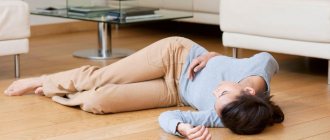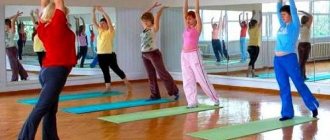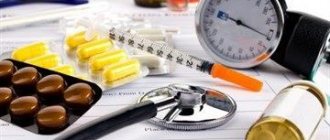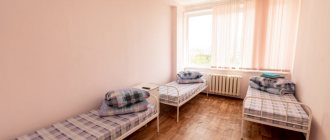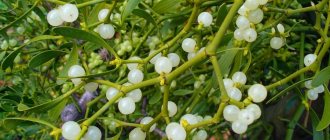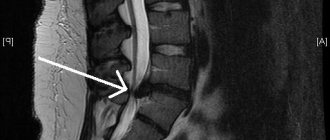Home » Vegetative-vascular dystonia
Category: Vegetative-vascular dystonia
Vegetative-vascular dystonia (VSD) is one of the most common diseases. The disease can accompany a person throughout his life and significantly spoil the quality of life. Such a diagnosis cannot be tolerated, especially since you can fight it right at home. Treatment of vegetative-vascular dystonia at home will lead to a successful result only if there is an integrated approach, correct use of medications and implementation of health procedures.
- Drug treatment
- Physiotherapy at home
- Treatment with water
- Health-improving exercises
- Natural remedies
- With high blood pressure
- If the pressure is low
- Aromatherapy
- Choosing the right lifestyle
Three rules for a patient with VSD
Before considering the main treatment methods, it is worth recalling the recommendations. They are aimed at preventing the patient from harming himself:
- Don't self-diagnose. As a rule, patients exhibit only two or three symptoms from a long list of signs of VSD, which are practically not felt. But many people think that you can die from these signs. Patients are deeply mistaken, since the disease can be successfully cured by a doctor after a thorough examination.
- Do not take any medications on your own. Some of the medications used to treat VSD have severe side effects. An incorrectly selected list of medications can nullify the results of therapy. The patient may die from drug incompatibility.
- Only the patient’s desire to be cured becomes the decisive factor in the therapy process. If the patient has come to terms with the diagnosis and is in a state of depression, then no medications can cure him of VSD forever. Depression, laziness and despondency can lead to exacerbation of pathology.
The cause of the disease must be treated first
if it is caused by any other disease. It is because of them that the patient can die, since VSD exacerbates painful processes in the body. Most often this syndrome is caused by:
- hormonal imbalances in the body;
- traumatic brain injury;
- tobacco and alcohol addiction;
- respiratory tract infections.
itself is not fatal.
However, it greatly reduces the quality of life. Moreover, in medicine they are classified as a syndrome - i.e. a collection of symptoms caused by one pathology, and not as a separate disease. The patient may die if VSD leads to other diseases that are not diagnosed in time.
Unfortunately, in medicine there is still no consensus on the origin and method of eliminating the manifestations of VSD. Therefore, it is necessary to be treated only by a qualified and experienced doctor.
Herbal infusions
To prepare this collection, you will need a large amount of various herbs:
These plants should be taken one and a half tablespoons, and the following two:
- dill seeds;
- St. John's wort;
- yarrow;
- sagebrush;
- valerian;
- chamomile;
- sweet clover;
- calendula.
All the herbal components of the future infusion must be mixed and take just one tablespoon. Pour half a liter of boiling water over this mixture, let it brew for half an hour and strain. The infusion can be stored for no more than two days in the refrigerator. Take it for twenty days three times a day. After this time, you need to take a break for a week, then repeat it all over again, and so the total number of cycles is five times. But after the first time, they no longer brew one spoonful of the herbal mixture, but two.
Motherwort infusion. A glass of boiled water should be poured with ten grams of dry motherwort. Take the entire infusion four times a day, and the last portion just before night. This whole procedure should last a month.
Valerian tea. Valerian root in the amount of fifteen grams must be crushed and poured with two hundred milliliters of boiling water. The container into which the liquid will be poured must be tightly closed.
Leave to brew for twelve hours and take twenty milliliters three times a day. The last dose should also be before bedtime. Treatment with this tea is allowed for quite a long time.
Non-drug methods
The set of measures described below is used to normalize the patient’s lifestyle. They will be enough to nullify VSD in a mild form. Here is a basic list of actions that can help against acute forms of the disease:
- moderate physical activity;
- rational balanced nutrition;
- normalization of the daily routine;
- avoidance of stressful situations;
- psychotherapy and massage;
- physiotherapy.
You also need to adhere to a certain diet. First of all, the disease is associated with a violation of the sodium-potassium balance. To get rid of the cardiac type of VSD, it is recommended to minimize the consumption of potassium-containing foods and resume normal salt intake.
For patients suffering from a hypertensive type of VSD, on the contrary, it is necessary to reduce sodium intake and add the following foods to your diet: bananas, nuts, parsley, onions, cereals. They contain potassium, which normalizes heart rate. Also, the patient must say a firm “no” to alcoholic and stimulating drinks.
For hypotensive patients, it is better to eat foods rich in iodine (fish, seaweed, iodized salt) and calcium (hard cheeses, cottage cheese). Caffeine-containing drinks (tea, coffee) can also improve vascular tone.
In acute attacks of VSD, it is recommended to take herbal remedies. The greatest calming effect can be obtained from decoctions of mint, hops, valerian and sage. During attacks, you need to relax as much as possible. It is better to breathe with the diaphragm, i.e. drawing the collected air down to the stomach.
Also, to get rid of the manifestations of VSD, physiotherapeutic measures are used: vacuum therapy, exposure to magnetic and laser radiation and electrophoresis.
First aid for a VSD crisis
A crisis against the background of VSD can be triggered by a number of factors, including menstruation, weather anomalies, and emotional excitement. To provide high-quality first aid, you need to proceed from the type of VSD attack.
There are three of them in total:
- Adrenal. Such a crisis is indicated by severe headache, increased heart rate, cold extremities, and trembling in the body. Against the background of intensification of these pathological signs, a person’s feeling of fear increases, blood pressure rises to 150-180 mm. rt. Art.
The rules for providing first aid for an adrenal attack are as follows:
You need to insist that the person begins to breathe deeply. While filling the chest with air, you should stop breathing for a few seconds. It is necessary to repeat such deep breaths at least 6 times.
- You can massage the eyeballs and supraclavicular area by applying light pressure with your knuckles.
- Mustard plaster should be placed on the back of the neck.
After completing these activities, the person will probably feel better. If there is no effect, then you can offer him water with drops of Corvalol or Valocordin dissolved in it (20 drops per 50 ml of water). Or you are allowed to take one Diazepam tablet. A single dose of Propranolol helps lower blood pressure.
- Mixed. If a person has a mixed type of crisis, then first aid depends on which symptoms predominate at the moment.
You can remove the symptoms of an attack of vegetative-vascular dystonia on your own. The patient must be provided with maximum rest. In order to help him get rid of unpleasant sensations, you need to place him in a dimly lit room.
Valerian tincture works well against PA. It can be replaced with Corvalol, Valocorlin, or peony tincture. If you cannot cope with the symptoms, you should call an ambulance.
The doctor may prescribe a drug that improves blood circulation in the brain or has a beneficial effect on the cardiovascular system.
Homeopathy can also help in the fight against vegetative-vascular dystonia. This method of treatment certainly has a number of advantages. For example, such drugs do not have side effects as such and do not provoke an allergic reaction. Homeopathic remedies are able to treat organisms using microdoses that correspond to the very symptoms of the disease.
Homeopathic medicines have a number of features such as:
- healing effect of the products;
- gradual action;
- stimulating human immunity.
It should be remembered that it is undesirable to take conventional medications together with homeopathic ones. It is best to seek help from a specialist, and he will tell you how to treat such a disease.
Prevention
If you were able to get rid of the disease forever, then you need to reduce the risk of relapse to nothing. The following factors will help keep your body in good shape:
- giving up bad habits once and for all;
- the most comfortable living conditions: work should be more or less mobile and alternate with rest;
- favorable climate;
- clear daily routine, physical education;
- resistance to negative emotions;
- positive mood, creativity, new acquaintances.
Breathing exercise for vegetative-vascular dystonia
Techniques for performing effective breathing exercises for VSD:
- Close one nostril and inhale, open it, holding the air inside.
- Close the other nostril and exhale.
This allows you to equalize the tone of the two hemispheres of the brain. Regular exercise for 15 minutes a day will significantly improve your well-being. You can feel the results after just two weeks of training.
Drugs
VSD is treated using various categories of drugs. When treating VSD with medications, the following rule is followed: in the first days, the minimum dose of the drug is prescribed, and then it is gradually increased.
To get rid of pathology, the following types of drugs are used:
- Antidepressants and tranquilizers. They are aimed against depression and the desire to die. The tablets stimulate the release of certain substances in the body, which give a feeling of joy and calm. It should be noted that today there is still no antidepressant that does not have side effects. In addition, many of them are addictive. An incorrectly selected psychotropic substance most often leads to a serotonin crisis due to which the patient can die. It will take an extra month of medication to get rid of it forever.
- Vitamins. VSD is accompanied by a general depletion of the body's resources. These substances help replenish these losses and normalize metabolism. The most commonly used are ascorbic acid (vitamin C) and tablets containing vitamin B.
- Medicines to improve blood circulation. Depending on the type of VSD, they bring blood pressure back to normal. They activate or suppress the activity of ion channels that regulate heart rate.
- Sedatives – calm and relieve stress. Does not cause drowsiness. They are used to get rid of mild attacks of VSD, when there is no need to use strong tranquilizers and antidepressants.
- Medicines that dilate blood vessels in the brain. They improve their conductivity and tone. Intended to eliminate drowsiness, dizziness and general weakness of the body.
- Mineral products. They replenish magnesium, selenium and zinc reserves, which are especially depleted during illness.
Vegetovascular dystonia (VSD) is a symptom complex caused by disruption of the autonomic nervous system, manifested by numerous disorders of the cardiovascular and respiratory systems, decreased resistance to stress, asthenia, and poor tolerance to physical activity. At the same time, VSD has a benign course and never leads to the development of heart failure and expansion of the chambers of the heart.
- Show all
Treatment of VSD with folk remedies
General trends
Treatment of vegetative-vascular dystonia with folk remedies includes a large number of different techniques.
The main part of them is based on the medicinal properties of herbal preparations , the positive effects of honey, berries and plant rhizomes on the human body.
When making preparations for tinctures and hot drinks, in the treatment of vegetative vascular disease, herbs, fruits and rhizomes of plants are used, which have sedative properties, have a calming effect and help relax the nervous system.
Psychological condition
It is necessary to try to pay as little attention as possible to factors that can throw you out of balance, and not to succumb to panic and
look at everything that happens with optimism.
For an everyday positive attitude, it’s good to take a contrast shower, listen to your favorite music, and try to be in the fresh air as much as possible.
It is also very important to exercise and maintain a daily routine.
Etiological treatment
Eliminating the cause of VSD in most cases significantly improves the patient's condition. However, it is quite difficult to establish the etiology of this syndrome.
The main etiological forms of VSD:
- hereditary-constitutional (determined by the mental and physical characteristics of a person);
- psychogenic;
- associated with physical stress;
- infectious-toxic (due to the presence of a chronic infection in the body);
- associated with professional and physical factors;
- mixed.
In the psychogenic form, it is necessary to avoid stressful situations.
The infectious-toxic form of VSD requires treatment of foci of chronic infection (timely visit to the dentist for the treatment of caries, sanitation of the throat, removal of tonsils if indicated).
If VSD is caused by professional factors, it is necessary to refuse to work in harmful conditions.
Excessive physical activity can also contribute to the development of VSD, so intense sports training and heavy physical labor should be temporarily excluded. Once your condition has stabilized, you can gradually expand your physical activity regimen.
Women often suffer from dystonia due to various hormonal changes and disruptions. In this case, treatment should be carried out together with a gynecologist or endocrinologist.
If VSD occurs against the background of organic pathology, then the emphasis should be on treating the underlying disease.
Light sports for VSD
Moderate physical activity helps train the cardiovascular and respiratory systems. Therefore, light sports for VSD are a prerequisite for recovery.
You should not start exercising on your own, as incorrect exercise technique or excessive loads can cause harm. The doctor must select a training regimen taking into account all the symptoms and characteristics of the course of the disease in each specific case.
Proper and sufficient nutrition must be combined with training, since a lack of calories will not allow the body to cope with physical activity. This, in turn, can lead to the development of another VSD crisis.
- Swimming is a sport that allows you to strengthen all systems of the body and have a positive impact on human health. Even short-term exercises in the pool provide an opportunity to relieve nervous tension, relieve joint stress, and increase muscle tone.
- It is better for people with VSD to avoid running. Race walking is more suitable for them. It is good to exercise outdoors, and you should walk short distances. The duration of training should increase gradually.
- A ride on the bicycle. This type of training allows you to saturate the body with oxygen, strengthen the immune system, and stabilize blood pressure. However, you should avoid traveling too long on difficult routes.
- Every morning you need to start with exercise. It will give you energy for the coming day, allow you to mobilize the body’s reserves, and improve your well-being. It's good to have the opportunity to train outdoors.
- Therapeutic gymnastics is a selected set of exercises that must be compiled by a doctor. It is therapeutic exercises that are one of the basic methods of treating VSD. The complex should be compiled by a specialist who has information about the state of human health.
- Yoga. This type of physical exercise allows you to strengthen your muscles and at the same time gain peace of mind. Doctors strongly recommend doing yoga to those patients who are prone to attacks of VSD.
- Breathing exercises. Breathing exercises can reduce the severity of negative manifestations of VSD.
In order not to harm your own health, you should definitely consult a doctor about the possibilities of playing a particular sport.
It is also worth paying attention to the following recommendations regarding the characteristics of training for people with VSD:
- The sports program should be selected taking into account the individual characteristics of each person;
- Prolonged cardiac exercise should not be combined with strength exercises;
- Between approaches you need to give the body a rest, and you should avoid performing heavy physical activity;
- During training, you need to monitor your breathing.
If your health allows, you can play volleyball, ice skating, skiing, and basketball. Sports such as martial arts, athletics and weightlifting, and boxing are prohibited.
People with hypertensive type VSD are advised to do breathing exercises, swimming, slow running and race walking. You need to avoid jumping, cardiological exercises, and running at speed. You should constantly monitor your pulse and blood pressure levels. Exercises must be performed at a calm pace, standing, lying or sitting. You need to breathe through your chest, inhaling air through your nose and exhaling through your mouth. If shortness of breath occurs, then you need to take a break and restore your breathing.
If the VSD has a hypotonic form, then you can engage in strength sports, cardio training, it is useful to do stretching, and perform exercises to develop coordination. It is good to practice at the wall bars and use dumbbells during training.
It is imperative to train the muscles of the abdominals, spine, upper and lower extremities. If the exercises involve the neck muscles, it is important to avoid sharp turns and bends. It’s good to end your workout with a contrast shower.
Psychotherapy and auto-training
Psychotherapy is the main method of treating VSD. Its effectiveness is several times greater than drug therapy. It is very important for the patient to understand the essence of the disease, to understand that the manifestations of the disease are not life-threatening and that it is quite possible to achieve a complete recovery.
There are certain forms of self-hypnosis that can significantly reduce the unpleasant symptoms of the disease. Maximum results can be achieved by combining self-hypnosis with auto-training according to the Schulz method and muscle relaxation.
Art plays an important role in the treatment of VSD: music, painting, theater, literature. Therapy using such methods is called aesthetic therapy.
Physiotherapy for vegetative-vascular dystonia
Physiotherapy in the treatment of VSD has become quite widely used. It is based on the effects of light, heat, water and healing mud. Physiotherapy for vegetative-vascular dystonia is used in combination with drug correction and as an independent type of treatment.
The following methods have proven themselves to be excellent:
- Electrophoresis with bromine, magnesium, aminophylline, papaverine - procedures produce a vasodilating effect;
- Arrhythmia can be eliminated using electrophoresis with calcium chloride, lidocaine, procainamide;
- Electrosleep;
- Magnetotherapy;
- A contrast shower has a distinct tonic effect;
- Coniferous and radon baths are indicated for excessive activity of the parasympathetic nervous system;
- Sulfide and carbon dioxide baths are prescribed when the functions of the sympathetic autonomic nervous system predominate;
- Dry air baths, pearl baths, and circular showers can increase vascular tone.
Pathogenetic treatment
Autonomic dysfunction occurs as a result of disturbances in the limbic system and hypothalamus. Their correction helps normalize the activity of the autonomic nervous system.
Phytotherapy
The most commonly used are valerian and motherwort. It is noteworthy that their effect is not limited to just a sedative effect. These herbs are able to act at the level of the brain stem and hypothalamus, which leads to the normalization of their functions.
Preparations based on belladonna (Bellataminal, Bellastesin) stabilize the functioning of both parts of the autonomic nervous system.
Improvement occurs after 2-3 weeks of taking herbal infusions, but to achieve a lasting effect it is necessary to continue treatment for up to 6-8 months.
If the condition is satisfactory, herbal medicine courses should be repeated for preventive purposes 2 times a year for 1-2 months, preferably in spring and autumn.
Tranquilizers
If the clinical picture is dominated by anxiety disorder, unmotivated fear, and constant psycho-emotional stress, then it would be advisable to prescribe tranquilizers. The most commonly used are Elenium, Diazepam, Phenazepam, Nozepam. The duration of the course should not exceed 2-3 weeks. It is optimal to take such drugs before an upcoming stressful situation. But if the patient’s activities require increased concentration and quick decision-making, then it is better to avoid tranquilizers.
Currently, daytime tranquilizers are widely used - Mebicar (Adaptol), Grandaxin. Their advantage is the absence of hypnotic and muscle relaxant effects.
Antidepressants
Often dysfunction of the autonomic nervous system develops against the background of depression, and in most cases it is masked by various somatic and neurological manifestations. The selection of antidepressants is carried out depending on the form of depression. The dosage is selected individually, starting with a small dose with a gradual increase to the optimal one. Duration of therapy is from 2 to 6 months.
In some cases, a combination of antidepressants and tranquilizers is required.
Nootropics and cerebroangitoprotectors
Nootropics (Piracetam) have a positive effect on the functioning of the hypothalamus and limbic system. By improving metabolic and energy processes in the brain, mental functions are activated and memory is improved, which is especially important for patients whose activities involve intellectual work.
If VSD is combined with cervical osteochondrosis and is manifested mainly by dizziness and headache, it is advisable to use drugs that improve blood supply to the brain (Vinpocetine, Cinnarizine).
Beta blockers
An increase in the tone of the sympathetic department of the autonomic system is manifested mainly by a tendency to tachycardia, paroxysmal rhythm disturbances, low exercise tolerance, increased blood pressure, and frequent sympathoadrenal crises.
To reduce sympathoadrenal activity, beta-blockers (Anaprilin, Metoprolol, Bisoprolol) are used. Usually, 2-4 weeks of the course are enough to improve your well-being, after which the drug can be discontinued.
Other popular recipes
Tinctures prepared according to the following recipes are considered quite effective:
One glass of dry dill seeds and a couple of tablespoons of valerian root should be poured with boiling water (about a liter of liquid), let it brew in a thermos for 24 hours. After this, add two glasses of honey.
Mix everything together and put it in the refrigerator. The resulting solution is taken one tablespoon 3 times a day shortly before meals.
In cases where vegetative vascular distance is accompanied by high blood pressure, an infusion of:
- white mistletoe leaves - 2 tablespoons;
- pharmacy magnolia extract - 1 tablespoon;
- blueberries - half a tablespoon;
- currant fruits - half a tablespoon;
- barberry fruits - half a tablespoon;
- peppermint - one and a half tablespoons;
- calendula flowers - one tablespoon;
- sweet clover herb - one tablespoon;
- oregano leaves - one tablespoon;
- dill seeds - one and a half teaspoons.
Pour the resulting mixture of herbs into three liters of boiling water and leave in a thermos for 24 hours. After which, it is recommended to drink three times a day, one or two tablespoons per dose. The course lasts about 15-20 days, depending on the degree of development of the disease.
To generally strengthen the immune system, you can take a 10-day course of using the tincture:
- pharmacy tincture of valerian in drops - 40 - 50 drops;
- sandy immortelle - three tablespoons;
- elecampane (root) - one tablespoon;
- carrot juice - five tablespoons;
- decoction of rose hips - one glass (200-250 ml);
- hawthorn berries - one tablespoon.
The resulting mixture must be poured with two liters of boiling water and left for 24 hours. After this, the solution is taken twice a day, 3 tablespoons per dose. The prepared composition must be stored in the refrigerator.
Physiotherapy, acupuncture, massage
Electrosleep normalizes brain function, reduces pain in the heart area, and reduces the frequency of extrasystoles.
Electrophoresis with various drugs helps combat the manifestations of VSD. If there is a tendency to increase blood pressure and tachycardia, electrophoresis of aminophylline, magnesium sulfate, potassium bromide, papaverine is used; for low pressure, caffeine electrophoresis is used.
In patients with VSD, water procedures have a good positive effect.
A circular shower has a tonic and restorative effect. Underwater shower massage combines several therapeutic components:
- bath with the addition of various herbs, salts, essential oils;
- massage effect of the shower jet;
- temperature contrast between bath and shower.
Valerian, pearl, and pine baths have a calming effect. For severe cardiac syndrome, radon and iodine-bromine baths are recommended. For headaches, local effects are used as a distraction therapy: mustard or unleavened foot baths, paraffin boots and Gauff baths.
A restorative massage helps to get rid of the manifestations of VSD (in the presence of osteochondrosis, a gentle effect on the collar area and thoracic spine is indicated).
An effective treatment method is acupressure. The procedure can be performed by both the doctor and the patient himself.
A significant improvement in the well-being of patients is noted after acupuncture. Acupuncture, both traditional and in the form of electroacupuncture, helps normalize the activity of the nervous system, improves the ability to adapt, relieves headaches and pain in the heart, and stabilizes blood pressure.
Psychotherapy for VSD has been actively used for decades. Advice from a psychologist helps to cope with unpleasant symptoms and provides an opportunity to understand internal problems and complexes. Vegetative-vascular dystonia loses ground with a correctly selected treatment method, even without medications.
Medicinal herbs for normal, low and high blood pressure
When patients with vegetative-vascular dystonia have blood pressure within normal limits, the following medications can help them:
- Pour a tablespoon of crushed immortelle into a glass of boiling water and leave for fifteen minutes, then strain. Such treatment should occur for four days, three times a day, half a glass.
- Rosehip tea and freshly squeezed carrot juice significantly alleviate the characteristic symptoms.
- For this infusion you will need dry elecampane root in the amount of thirty grams, which should be poured with a liter of boiled water. The resulting mixture must be boiled for another fifteen minutes and cooled. This decoction is taken for a month, four times a day, two spoons.
If a person with VSD also has high blood pressure, then with these symptoms, preference should be given to the following recipes:
- To prepare, you need a glass of ordinary boiled water, into which you should put ten grams of hawthorn. Place the resulting mixture in a water bath for approximately fifteen minutes. Wait until it all cools down, then take one tablespoon three times a day.
- Vitamin tea will require the preparation of dried barberries, rowan berries, blueberries and currants in equal proportions. Use this mixture as tea leaves and take it instead of tea.
- For this recipe, you need to take magnolia leaves in the size of one spoon, which should be filled with a tablespoon of alcohol. Store the resulting product in the dark for several weeks. Use the strained mixture in twenty drops, which should be added to fifty milliliters of water, and drunk three times a day.
Vegetative-vascular dystonia is often accompanied by low blood pressure; to eliminate its symptoms, the following recipes will be required:
- Ten grams of dandelion, twice as much blackberry and birch, as well as three nettle leaves. Then you should mix it and pour 0.25 liters of boiling water over it. What happened was placed on a hot stove for literally a few minutes, then left for an hour. Take 2 tablespoons three times before meals.
- If you have low blood pressure, you should drink tea made from dried St. John's wort with angelica; you will need a ratio of 10:1, respectively. This is placed in a vessel that can be tightly closed and placed in the oven. Use the herb as a regular tea and take only twice a day.
- You will need about one hundred grams of rosea rhodiola roots, which should be filled with half a liter of vodka. Place the mixture in the dark for a week. It is worth noting that the mixture should be shaken more often. This is taken in the following way - 10 drops are diluted with water and taken three times a day. It is recommended to use the tincture for no more than a month.
Thus, we can draw a simple conclusion that it is quite possible to defeat vegetative-vascular dystonia with the help of traditional methods and medications, and a correct lifestyle will not allow its symptoms to reappear.
Etiology and pathogenesis of the problem
Vegetative-vascular dystonia is associated with malfunctions of the autonomic system. The main symptoms include asthenia, dizziness and other life-impairing symptoms. Modern medicine does not recognize VSD as a disease, and this disease cannot be found in the official list of WHO diseases. It is believed that such a disorder is a consequence of stress, emotional upheaval, and overexertion, so it is recommended to begin treatment with the help of a psychotherapist or psychologist.
Enter your pressure
Move the sliders
Symptoms of VSD are diagnosed in 80% of the world's inhabitants. In most cases, a person simply does not notice attacks of the disease, since an aggravation of the disease requires a stimulus: heavy physical activity, stress, lack of sleep, depression, etc. The first attack is so unexpected for a person that it is remembered for a lifetime. Doctors call this condition. It is accompanied by:
- tachycardia;
- pressure surges;
- heart sinking;
- lump in throat;
- panic fear;
- cold sweat;
- disturbances in breathing rhythm.
Psychotherapy, physical therapy and medications are effective in treating VSD.
A psychologist, neurologist and psychotherapist are the main specialists in VSD. The main goal of treatment is to restore the balance of a person’s mental strength, to normalize the mental balance of the individual. A psychiatrist looks for the cause of a person’s complexes and fears, and teaches him to live with them, manage and direct them in the right direction. A person learns to relax with the help of special techniques and breathing exercises. The use of physical therapy and massages is also effective.
Do not ignore psychological help. For decades, it was believed that mental illness was a whim. A competent specialist will help you fight VSD, deal with fears and conflicts, and teach you to understand your reactions and manage them. In the early stages of the disease, these skills treat most symptoms.
What to do during an attack?
Regardless of the severity of the attack, a person should always remember that this disease is not life-threatening, so it is worth learning to take it as calmly as possible. If an illness is approaching, a person is able to diagnose its symptoms, and over time can learn to ignore the attack and shift attention. Rules of conduct during an attack:
- Provide access to fresh air, open a window, unbutton the top buttons of a shirt or dress.
- Lie down, but your head should be lower than your legs to allow blood flow to the brain. If this does not work, you need to immerse your feet in warm water (only if the patient does not suffer from varicose veins) and cover yourself with a blanket.
- Take a herbal sedative (Novopassit, Valerian, Valocordin). If it doesn’t help, you can take half a Phenozepam tablet.
Even if it is very difficult and scary, you should not abuse nootropic or antipsychotic drugs, as they worsen the course of the disease.
What is prohibited in VSD?
An overdose of sedative medications in the presence of a disease is dangerous to the patient’s health.
Certain activities and actions are strictly prohibited for people suffering from vegetative-vascular dystonia:
- sedentary, inactive life;
- consumption of caffeine-containing drinks (energy drinks, tea, coffee);
- excessive consumption of B vitamins;
- extreme sports;
- drinking alcohol, smoking;
- watching thrillers, horror films, melodramatic programs - any content that evokes negative emotions;
- abuse of sedatives;
- fear of another attack approaching;
- long work at the computer.
It is not recommended to eat foods that irritate nerve cells. If large crowds of people cause panic attacks, it is better to avoid the crowd, but there is no need to refuse human society - this will aggravate the painful condition. You should not sunbathe too much and, if possible, you should avoid traveling on public transport during rush hour. VSD is best treated by psychotherapy, fresh air, restful sleep and the practiced skill of coping with one’s fears.
BREATH. I’ll say right away that breathing is a THING! I would never have believed it if I hadn't checked it for myself. So, we lie down horizontally. Eyes closed. The inhalation is ordinary, but full: both the stomach and the chest are inflated. Full, but without tearing!!! This means don't overdo it. Then we hold our breath for 2-3 seconds. And slowly, slowly exhale. The whole trick is in exhalation: first the stomach slowly lowers, then the chest. So slow. We focus all our attention on ourselves, on our exhalation. We don't think about anything else!!! After exhalation, immediately take the next breath without holding your breath, etc. It turns out like this: inhale - hold - slow exhale - inhale - hold - slow exhale... What happens in this case: the blood is filled with oxygen, the vessels dilate, oxygen enters the cardiovascular system. Do this in the morning after waking up and in the evening before going to bed. If you still have time to do it during the day, that’s great! In addition, if for some reason your “heart is pounding furiously,” lie down, close your eyes (if this is not possible, then while standing) breathe, and you don’t need anaprilin. If you breathe correctly, it goes away. If the PA covers it, the breathing starts again and lets go. You can even just measure your pulse: with this exhalation it slows down. It was like this for me: I started to feel sick, I lay there “resting”, then I started to recover, my arms and legs were trembling, my jaws were chattering, teeth were missing. Started to breathe. When I inhale, I feel sick, I tremble all over, and when I exhale there is silence (the jaws rest, relaxation), again knock-knock with my teeth, again slowly exhale and relax, etc. until complete relaxation... I kept chattering my teeth every other time :))) When you master this technique (my doctor timed with a stopwatch how long my exhalation lasted. The longer, the better), so, the next step is EXHALE + THE WORD that you came up with (see above) to say to yourself. For what? I already wrote that when exhaling, don’t think about anything! So the word that you repeat as you exhale helps obsessive thoughts get out of your head. We immediately kill two birds with one stone: we work on the vessels and free the head from... guess for yourself why. And it turns out INHALE - HOLD YOUR BREATH - SLOW EXHALE with repeating the word (silence, silence, etc...) Until you master breathing well, and this is a week, at least do not add a word. First, work on breathing correctly, then, when breathing has become automatic, add a word. Regarding how long you need to practice breathing before you improve... It is clear that each of us is individual, and everyone’s cases are different. Everything influences: age, the “neglect” of the disease, the body’s resistance, etc. (you can again find fault with words and figures of speech, but those who need it will understand what I’m talking about...). But a couple of days or weeks is not a long time. Especially without the use of medications. The first time, when I was 20 years old, it happened very quickly, literally a couple of months without taking medication. Then I stopped studying and forgot about VSD. The second time - longer. And in the third - I was already 35, it lasted a year, and with light pills. I was already in despair, crying that what had helped me before was not helping me. But over the years, the body’s resistance weakens... A year later there was an improvement. Therefore, I URGE you not to stop after improvement, even if you feel completely healthy!!! After all, it’s not so difficult to breathe in the morning and evening before bed???!!! I already have it automatic, I lay down in bed and take 7-10 breaths. My breathing pattern was exactly as I described! I've read about many others. But that's how I breathed. She held her breath for 2-3 seconds and exhaled slowly. First for 8 counts, then longer (it reached 20-30 seconds). Then, when I became automatic, I began to notice that when I get scared, I automatically hold my breath and exhale slowly. I do the same thing when my heart is “pounding furiously” during physical activity or nervous stress, or I just suddenly woke up in the middle of the night, and my heart is ready to jump out of my chest... I start to breathe - it slows down its rhythm (precisely when I exhale). Then when you inhale again a little faster, exhale slowly again - and it calms down. The rhythm is even. It’s as if you’re slowing it down by exhaling slowly. The same thing happens when you feel a strong chill (with PA). When you exhale slowly, the trembling stops, and when you inhale, you tremble again. And so the PA falls silent. About breathing simply with your stomach. Don't know. When I started breathing according to the system I described, I didn’t “connect” my stomach at all, and even without this, improvement came. Then the doctor just told me that you, my dear, don’t do any work with your stomach... I breathed for therapeutic and prophylactic purposes mainly while lying down, but with PA - as necessary. It helped anyway. It especially helps with pronouncing words to yourself while exhaling. Immediately the brain “switches off” from fear. No attention to inhalation, it happens arbitrarily, all attention to exhalation + word. Be sure to pronounce the word - it will help you not to be scared during PA, it will turn on automatically!!!
A common pathological condition. It is diagnosed in more than half the population, mainly in adolescents and women. Although dystonia does not pose an immediate threat to life, it disrupts the normal functioning of the body. How to deal with VSD using various methods?
The essence of vegetative-vascular dystonia is the formation of a persistent imbalance in the work of the sympathetic and. VSD does not arise as an independent disease, but as a symptom complex that accompanies somatic and psychological pathology.
Dystonia has a chronic course. It remains even after the underlying disease has been eliminated. The condition occurs with periods of remissions and exacerbations. In remission, a person feels certain symptoms, but his ability to work and his usual way of life are not disrupted. During an exacerbation, which is short-term in nature, all manifestations intensify and this leads to disruption of the rhythm of life.
Eltacin for VSD
Eltacin is a combination drug prescribed for the treatment of VSD. It consists of three amino acids: cysteine, glutamine, glycine.
The use of Eltacin allows you to achieve the following positive effects:
- Improvement of cognitive abilities;
- Uplifting mood;
- Elimination of aggression and irritability;
- Normalization of sleep;
- Restoration of the autonomic nervous system;
- Improving blood microcirculation in various organs;
- Stimulation of metabolic processes in the brain;
- Facilitation of social adaptation.
A significant advantage of the drug is that it can be used to treat VSD not only in adults, but also in children over 12 years of age. In addition, Eltacin is very well tolerated by most patients and does not have a negative effect on the body. The drug is very convenient to use. After all, you just need to put the tablet under your tongue and wait until it dissolves on its own.
Side effects from taking Eltacin are extremely rare. Sometimes allergic reactions and nausea are recorded, but, as a rule, it goes away within a few minutes.
The only contraindication to taking the drug is individual intolerance to its components. As for the prescription of the drug to children under 12 years of age and pregnant women, no clinical trials have been conducted on this subject. Therefore, the use of the drug in these categories of patients remains at the discretion of the physician.
As for the disadvantages of the drug, there is only one - it is a relatively high price. In addition, the official instructions for use indicate that Eltacin should be prescribed for the treatment of chronic heart failure. However, practicing neurologists very often use it specifically for the treatment of VSD.
Drug therapy
There is no single drug for vegetative dystonia. There is no etiotropic treatment because this is not a typical disease with a specific cause. Dystonia is a pathological condition that can manifest itself with various symptoms. All drug therapy is aimed at eliminating these symptoms. Therefore, not one drug is used, but several, from different groups.
The pathology is accompanied by neurological disorders, unpleasant sensations in the heart area, numbness and coldness of the extremities, and dyspeptic symptoms. What remedies are needed to correct all these symptoms?
Antidepressants and tranquilizers
Drugs of these groups are aimed at correcting the psychological state. Patients with VSD, especially adolescents and overly emotional women, often experience depressive thoughts. To prevent them from becoming suicidal, it is necessary to prescribe drugs from these groups.
- Afobazole is a drug with an anxiolytic effect. It does not cause drowsiness, therefore it is considered a daytime tranquilizer. Indicated for the symptomatic treatment of vegetative dystonia. Eliminates anxiety, normalizes sleep. Improves cognitive abilities. Due to the suppression of anxiety, spasm of internal organs and blood vessels decreases. This helps to weaken somatic manifestations.
- Grandaxin is a drug that is also a daytime tranquilizer. Regulates the functioning of the autonomic nervous system without having a hypnotic effect. Shown for .
- Adaptol is a strong anxiolytic. Provides reduction of anxiety, eliminates depressive mood. It does not have a hypnotic effect, but is able to normalize the physiological rhythm of sleep.
Stimulants
These medications increase vitality and improve mood. Supports performance, both mental and physical.
- Ginseng tincture is a natural remedy for stimulating the nervous system. Improves mental and physical performance. Its use is indicated for the symptomatic treatment of VSD in both adults and children over 12 years of age. To prevent insomnia, the drug is taken in the first half of the day.
- Eleutherococcus tincture is a plant adaptogen. Stimulates the activity of the nervous system. Helps reduce fatigue and improve mental abilities. Indicated for the symptomatic treatment of VSD in adults and children over 12 years of age.
- Stimol is a stimulant of synthetic origin based on citrulline. This is an amino acid that helps increase the adaptive properties of the body. Approved for use from the age of five.
Vitamins
Vitamin and mineral complexes are necessary to maintain energy, improve the functioning of the nervous system, and adapt the body to the environment.
- Doppelhertz Ginseng is a vitamin and mineral complex containing all the necessary components to combat dystonia. In addition to essential vitamins and minerals, the preparation contains ginseng extract, which has stimulating properties. Indicated as a course of treatment for dystonia.
- Doppelhertz Magnesium + Potassium is a vitamin containing magnesium and potassium. These microelements are necessary for the full functioning of the heart muscle. Improves the well-being of a person with VSD. With long-term use, they reduce the severity of discomfort in the heart area.
- Vitalotonic is a vitamin preparation in the form of a solution. Contains five plant extracts. Supports cardiac function and has a calming effect. Relieves spasms of smooth muscles, including the digestive tract. Increases physical performance. Indicated for the symptomatic treatment of VSD in adults.
Products for microcirculation
With vegetative-vascular dystonia, a spasm of capillaries in the periphery is observed. As a result, a person feels chilly in the limbs, pale and numb in the fingers. To eliminate this symptom, drugs are used to improve microcirculation.
- Pentoxifylline is a drug for improving microcirculation and strengthening the vascular wall. Normalizes the rheological properties of blood. Indicated for the treatment of peripheral circulatory disorders in vegetative dystonia.
Drugs to eliminate dyspepsia
With VSD, symptoms of indigestion may occur. They are not a sign of any disease, but they still need to be eliminated. The following drugs are used for this:
- Duspatalin is an antispasmodic that affects the smooth muscles of internal organs. Indicated for the treatment of dyspeptic disorders.
- Trimedat - has a dual effect on the digestive tract. It can both eliminate spasms and enhance peristalsis. It is used in the treatment of VSD to normalize the functioning of the gastrointestinal tract.
Treatment with medications is prescribed only by a specialist after a complete examination of the patient and identification of possible contraindications.
Nutrition for VSD
Nutrition for vegetative-vascular dystonia must be balanced and healthy.
The patient will have to give up alcoholic beverages, coffee, strongly brewed black tea, spicy foods, fatty meats and fast food. It is advisable to eat a couple of hours before bedtime, eat more vegetables and fruits, and arrange fasting days to cleanse the body. Sometimes, to get rid of vegetative-vascular dystonia, it is enough to adjust your diet.
When diagnosing VSD, you must adhere to the following recommendations:
- Remove canned food from the menu, refuse semi-finished products. In such products the amount of chemical components is extremely high. This allows them to stay fresh longer, but at the same time harms the human body.
- You should consume as little salt and caffeine as possible, otherwise an increase in blood pressure cannot be avoided. With VSD, its jumps are extremely undesirable.
- Spicy and fatty foods, as well as smoked foods, should be prohibited. This will relieve the burden on the pancreas, liver and other digestive organs.
- B vitamins are required for VSD. It is found in sufficient quantities in vegetables, eggs, cereals, fruits, dairy products, fish and meat.
As it becomes clear, VSD does not imply serious restrictions on the menu. Nutrition should be as balanced and complete as possible. This will provide the body with all the necessary vitamins and microelements.
During VSD, vascular tone is disrupted, so you need to include foods containing calcium, magnesium and potassium in your daily diet. These are products such as: buckwheat and oatmeal, legumes, cottage cheese, kefir, yogurt, honey, dried apricots, prunes, walnuts, parsley, dill. It is best to use olive oil and sunflower oil (unrefined) in cooking.
It is necessary to consume more freshly squeezed juices, various compotes (from dried fruits or fresh fruits and berries). Drink about two liters of water per day. You need to eat 3-5 times during the day.
In combination with proper nutrition, folk remedies, and a healthy lifestyle, you can get rid of vegetative-vascular dystonia forever.
Rehabilitation in a sanatorium is also prescribed for rehabilitation. Climatotherapy works well. Spa treatment, which includes balneotherapy, massage, exercise therapy, as well as physiotherapy procedures, is very useful.
The most common physiotherapeutic procedures are electrophoresis with medications (containing calcium, magnesium, bromine, novocaine, caffeine), electrosleep, various baths, mud treatment, and in some patients acupuncture.
If treatment at home with folk remedies does not give the expected result, the treating specialist prescribes medications for the treatment of vegetative-vascular dystonia.
Medicines are selected individually for each patient, the minimum dosage is prescribed, increasing until there is a positive effect.
Medicines for vegetative-vascular dystonia: glycine, pantogam, complexes of vitamins and microelements. To improve peripheral and cerebral circulation, cinnarizine and nicotinic acid are prescribed.
The most important thing is to consult a general practitioner and undergo an examination to determine the root cause of VSD. In combination with herbal treatment, exercise therapy, and proper nutrition, you can get rid of vegetative-vascular dystonia forever.
Non-drug treatment
Non-drug methods are also of great importance in the treatment of dystonia. In the fight against VSD, proper diet, rational physical activity, psychotherapy sessions and physiotherapeutic methods are used.
Diet
The first thing prescribed to patients with dystonia is diet. It does not imply strict restrictions. Therapeutic is adherence to the principles of healthy eating. The diet includes those foods that help improve well-being for different types of dystonia.
Nutrition should be complete and balanced, that is, include all the main products:
- meat products;
- fish products;
- cereals;
- dairy products;
- vegetables and fruits.
Canned foods, sweets, alcoholic and carbonated drinks are limited.
If you have a hypertensive type of VSD, you should limit your fluid intake and avoid drinking strong tea and coffee. It is also advisable to reduce the amount of table salt in food. Fruit drinks made from viburnum and chokeberry, and tea from hawthorn fruits can normalize blood pressure.
The hypotonic type, on the contrary, is an indication to increase the amount of fluid consumed to two liters per day. In this case, you need to regularly check for edema. If they appear, the drinking regime should be reconsidered. To maintain comfortable pressure, you can replace regular tea with green tea with jasmine. You can drink coffee, but you need to remember that it causes tachycardia.
It is necessary to develop a strict diet. It is better to take food in small portions, but more often, up to 4-5 times a day. There should be approximately equal periods of time between doses.
Adequate physical activity significantly improves the well-being of patients with dystonia. Daily morning exercises are shown, and walking in the evenings. Swimming, cycling, skiing, and skating help strengthen the nervous system and improve microcirculation. To improve lung function, running or walking over rough terrain is recommended. Strengthening cardiac activity is carried out with the help of cardio training. Individual sessions with physical therapy specialists are shown.
Physical exercises should be alternated with breathing exercises and relaxation exercises.
After training, you need to devote a few minutes to meditation or auto-training.
Training should be regular, but not exhausting. The level of physical activity is calculated in accordance with the age and capabilities of the body. You can devote only half an hour a day to physical education, but do it every day.
Psychotherapy
One of the important aspects of the fight against vegetative-vascular dystonia. The essence of the pathology lies in malfunctions of the brain and peripheral nerves. Psychotherapy is especially important for patients with frequent panic attacks.
A competent specialist will find out the cause of panic attacks and their accompanying manifestations. Several sessions of psychotherapy will help eliminate this problem. A psychologist's advice is especially important for young, emotional girls.
In addition to training with a specialist, you can perform some psychological techniques at home. This requires silence and a calm environment, so it is better to do this before bed or immediately after waking up.
Physiotherapeutic methods
Patients with insomnia or sleep inversion will benefit from electrosleep sessions. To normalize cardiac activity and blood pressure, therapeutic baths are used - salt, mud, mineral.
Methods such as acupuncture and acupressure are used. Improving the functioning of the peripheral nervous system and microcirculation is facilitated by hardening methods - walking barefoot, dousing with cold water, contrast showers.
Treatment of VSD with folk remedies
Due to the favorable course of vegetative-vascular dystonia, its treatment with folk remedies is very popular. The use of traditional methods always carries a high risk of developing adverse and allergic reactions, and with herbal remedies this risk is significantly less. There are also very effective exercises and combined folk recipes for the treatment of VSD .
As for exercises for VSD, there is nothing complicated here. All of them can be performed at home, without special preparation. At the initial stage, regular morning exercises will do. The main emphasis should be on warming up the neck muscles, breathing exercises and mobility of the spinal column. Some special therapeutic exercises should be carried out in a special room under the supervision of a physical therapist.
Also from sports disciplines the following will be very useful:
- swimming;
- cycling;
- athletics (excluding strength elements);
- aerobics;
- gymnastics.
Is it possible to get rid of VSD forever?
If such a diagnosis is made and laboratory confirmed to a person, then he is concerned about how to overcome VSD. Patients, when turning to a doctor for help, expect to be prescribed medications that can relieve them of their disease. They are very surprised when the doctor recommends other methods of therapy. The fact is that VSD is not a physical disease, although it leads to functional impairments. The illness is more psychological in nature. The success of therapy depends on the mood of the patient himself, his ability to resist the rolling “wave of fear.”
The doctor’s task is to explain to a person how to deal with attacks of VSD on his own, without resorting to the help of doctors. The use of medications is practiced in extreme cases, when all conservative treatment methods have not yielded positive results.
Diagnostics
Diagnosing vegetative-vascular dystonia is difficult due to the variety of symptoms and the lack of clear objective parameters. In the case of vegetative-vascular dystonia, we can rather talk about differential diagnosis and exclusion of organic pathology of a particular system. To do this, patients undergo consultation with a neurologist, endocrinologist and examination by a cardiologist.
Diseases similar to dystonia:
- Rheumatism is very similar to VSD in its symptoms.
- If blood pressure is high, the presence of arterial hypertension is ruled out.
- VSD can also be confused with bronchial asthma, mainly due to attacks of suffocation and shortness of breath in children during crises.
- If fever is present among the symptoms, the presence of an infectious or oncological disease should be excluded.
- The presence of mental disorders also requires refutation.
For all this, additional consultations with specialists such as an ophthalmologist, ENT doctor, or psychiatrist may be required.
Which doctor should I contact?
Vegetative-vascular dystonia is a nervous disease, and therefore, if you suspect this pathology, you should consult a neurologist. It is the neurologist who is the main specialist involved in the treatment of vegetative-vascular dystonia. However, depending on the symptoms a person has, a neurologist may refer the patient for consultation to other doctors whose competence includes treating the organ from which disturbing symptoms are observed. Therefore, treatment is often carried out jointly by doctors of several specialties. Most often, patients are observed by neurologists in collaboration with cardiologists.
Physical training
To get rid of VSD on your own, you need to perform therapeutic exercises. It helps relieve tension and has a positive effect on the functioning of the whole body. In addition, thanks to physical education, the health of the patient is improved and the physical activity of the patient increases.
You can defeat VSD on your own with the help of:
- jogging short distances or training on a treadmill;
- riding a bicycle or exercise bike;
- aerobics, water aerobics, swimming or breathing exercises.
After physical activity, it is advisable to perform a therapeutic massage. If you have vegetative-vascular dystonia, it is forbidden to engage in fast running, athletics and heavy strength exercises.
Which doctor treats VSD?
The problems of people suffering from VSD are dealt with by:
- therapists;
- cardiologists;
- neurologists;
- Psychiatrists (for frequent attacks of hysteria).
In addition, consultation with specialists may be required, depending on the observed manifestations.
Advice! Patients with VSD need to remember that the body will not kill itself with an increased release of adrenaline. Therefore, you need to learn to control your emotions and know that panic will not lead to death.
How to live with VSD?
In order to overcome the disease, you need to radically change your usual lifestyle. First of all, find out and get rid of the provocateurs of the attacks. In the future, change your lifestyle and follow certain rules.
- Proper nutrition, adherence to drinking regime.
- Daily morning jogs for 30-40 minutes (running slowly).
- Exercises in the gym (without “carrying iron”).
- Play sports all year round (skating, skiing, cycling, swimming).
- Daily morning exercise.
- Yoga.
- Cold and hot shower.
- Visiting the bathhouse, sauna.
- Stress-free work.
- “Listen” to the body less.
- Learn to find positive moments even in unpleasant situations.
- Don’t complain to anyone about your health, this will save you from the constant “rotation” of your symptoms.
In addition, you need to get enough sleep, not overwork, and avoid stress. Before going to bed, do not watch “scary movies” or emotional programs, so as not to excite the nervous system. For the same purpose, you should not eat before bed. A heaviness in the stomach does not contribute to sound sleep.
Life with VSD

